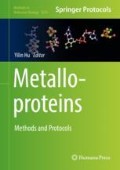Abstract
Molybdoenzymes are ubiquitous and play important roles in all kingdoms of life. The cofactors of these enzymes comprise the metal, molybdenum (Mo), which is bound to a special organic ligand system called molybdopterin (MPT). Additional small ligands are present at the Mo atom, including water, hydroxide, oxo-, sulfido-, or selenido-functionalities, and in some enzymes, amino acid ligand, such as serine, aspartate, cysteine, or selenocysteine that coordinate the cofactor to the peptide chain of the enzyme. The so-called molybdenum cofactor (Moco) is deeply buried within the protein at the end of a narrow funnel, giving access only to the substrate. In 1974, an assay was developed by Nason and coworkers using the pleiotropic Neurospora crassa mutant, nit-1, for the reconstitution of molybdoenzyme activities from crude extracts. These studies have led to the understanding that Moco is the common element in all molybdoenzymes from different organisms. The assay has been further developed since then by using specific molybdenum enzymes as the source of Moco for the reconstitution of diverse purified apo-molybdoenzymes. Alternatively, the molybdenum cofactor can be synthesized in vitro from stable intermediates and subsequently inserted into apo-molybdoenzymes with the assistance of specific Moco-binding chaperones. A general working protocol is described here for the insertion of the bis-molybdopterin guanine dinucleotide cofactor (bis-MGD) into its target molybdoenzyme using the example of Escherichia coli trimethylamine N-oxide (TMAO) reductase.
Access this chapter
Tax calculation will be finalised at checkout
Purchases are for personal use only
References
Hille R, Hall J, Basu P (2014) The mononuclear molybdenum enzymes. Chem Rev 114:3963–4038
Hu Y, Ribbe MW (2013) Biosynthesis of the iron-molybdenum cofactor of nitrogenase. J Biol Chem 288:13173–13177
Leimkühler S, Iobbi-Nivol C (2016) Bacterial molybdoenzymes: old enzymes for new purposes. FEMS Microbiol Rev 40:1–18
Schwarz G, Mendel RR, Ribbe MW (2009) Molybdenum cofactors, enzymes and pathways. Nature 460:839–847
Hille R (1996) The mononuclear molybdenum enzymes. Chem Rev 96:2757–2816
Reschke S, Sigfridsson KG, Kaufmann P et al (2013) Identification of a bis-molybdopterin intermediate in molybdenum cofactor biosynthesis in Escherichia coli. J Biol Chem 288:29736–29745
Reschke S, Mebs S, Sigfridsson-Clauss KG et al (2017) Protonation and sulfido versus oxo ligation changes at the molybdenum cofactor in xanthine dehydrogenase (XDH) variants studied by X-ray absorption spectroscopy. Inorg Chem 56:2165–2176
Nason A, Lee K-Y, Pan S-S et al (1974) Evidence for a molybdenum cofactor common to all molybdenum enzymes based on the in vitro assembly of assimilatory NADPH-nitrate reductase using the Neurospora mutant nit-1. J Less Com Met 36:449–459
Leimkühler S, Wuebbens MM, Rajagopalan KV (2011) The history of the discovery of the molybdenum cofactor and novel aspects of its biosynthesis in bacteria. Coord Chem Rev 255:1129–1144
Johnson JL, Rajagopalan KV (1982) Structural and metabolic relationship between the molybdenum cofactor and urothione. Proc Natl Acad Sci U S A 79:6856–6860
Schindelin H, Kisker C, Hilton J et al (1996) Crystal structure of DMSO reductase: redox-linked changes in molybdopterin coordination. Science 272:1615–1621
Chan MK, Mukund S, Kletzin A et al (1995) Structure of a hyperthermophilic tungstopterin enzyme, aldehyde ferredoxin oxidoreductase. Science 267:1463–1469
Romão MJ, Archer M, Moura I et al (1995) The crystal structure of xanthine oxidase related aldehyde oxidoreductase. Science 270:1170–1176
Rajagopalan KV (1996) Biosynthesis of the molybdenum cofactor. In Escherichia coli and Salmonella. In: Neidhardt FC (ed) Cellular and molecular biology. ASM Press, Washington, DC, pp 674–679
Mendel RR, Leimkühler S (2015) The biosynthesis of the molybdenum cofactors. J Biol Inorg Chem 20:337–347
Giordano G, Santini CL, Saracino L et al (1987) Involvement of a protein with molybdenum cofactor in the in vitro activation of nitrate reductase from a chlA mutant of Escherichia coli K12. Biochim Biophys Acta 914:220–232
Pommier J, Mejean V, Giordano G et al (1998) TorD, a cytoplasmic chaperone that interacts with the unfolded trimethylamine N-oxide reductase enzyme (TorA) in Escherichia coli. J Biol Chem 273:16615–16620
Genest O, Ilbert M, Mejean V et al (2005) TorD, an essential chaperone for TorA molybdoenzyme maturation at high temperature. J Biol Chem 280:15644–15648
Genest O, Neumann M, Seduk F et al (2008) Dedicated metallochaperone connects apoenzyme and molybdenum cofactor biosynthesis components. J Biol Chem 283:21433–21440
Genest O, Mejean V, Iobbi-Nivol C (2009) Multiple roles of TorD-like chaperones in the biogenesis of molybdoenzymes. FEMS Microbiol Lett 297:1–9
Stewart V, MacGregor CH (1982) Nitrate reductase in Escherichia coli K-12: involvement of chlC, chlE, and chlG loci. J Bacteriol 151:788–799
Ilbert M, Mejean V, Giudici-Orticoni MT et al (2003) Involvement of a mate chaperone (TorD) in the maturation pathway of molybdoenzyme TorA. J Biol Chem 278:28787–28792
Lake MW, Temple CA, Rajagopalan KV et al (2000) The crystal structure of the Escherichia coli MobA protein provides insight into molybdopterin guanine dinucleotide biosynthesis. J Biol Chem 275:40211–40217
Hartmann T, Leimkühler S (2013) The oxygen-tolerant and NAD-dependent formate dehydrogenase from Rhodobacter capsulatus is able to catalyze the reduction of CO to formate. FEBS J 280:6083–6096
Kisker C, Schindelin H, Pacheco A et al (1997) Molecular basis of sulfite oxidase deficiency from the structure of sulfite oxidase. Cell 91:973–983
Temple CA, Rajagopalan KV (2000) Optimization of expression of human sulfite oxidase and its molybdenum domain. Arch Biochem Biophys 38:281–287
Kessler DL, Rajagopalan KV (1972) Purification and properties of sulfite oxidase from chicken liver. Presence of molybdenum in sulfite oxidase from diverse sources. J Biol Chem 247:6566–6573
Acknowledgments
The authors are supported by the Deutsche Forschungsgemeinschaft grants LE1171/6-2 and the Cluster of Excellence “Unicat” Exc314, coordinated by the TU Berlin (to S.L.), and the CNRS and AMU (to C. I.-N.)
Author information
Authors and Affiliations
Corresponding author
Editor information
Editors and Affiliations
Rights and permissions
Copyright information
© 2019 Springer Science+Business Media, LLC, part of Springer Nature
About this protocol
Cite this protocol
Kaufmann, P., Iobbi-Nivol, C., Leimkühler, S. (2019). Reconstitution of Molybdoenzymes with Bis-Molybdopterin Guanine Dinucleotide Cofactors. In: Hu, Y. (eds) Metalloproteins. Methods in Molecular Biology, vol 1876. Humana Press, New York, NY. https://doi.org/10.1007/978-1-4939-8864-8_9
Download citation
DOI: https://doi.org/10.1007/978-1-4939-8864-8_9
Published:
Publisher Name: Humana Press, New York, NY
Print ISBN: 978-1-4939-8863-1
Online ISBN: 978-1-4939-8864-8
eBook Packages: Springer Protocols

